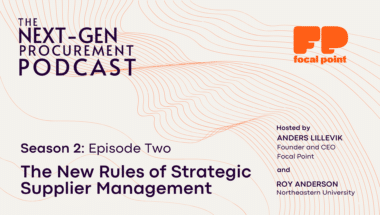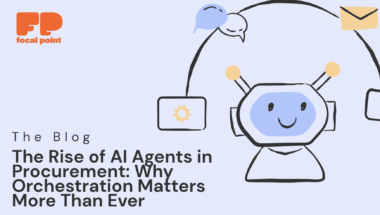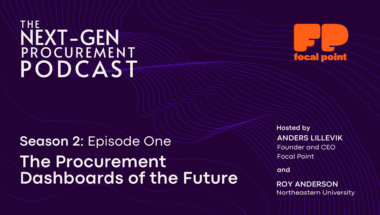Procurement professionals know that in the fast-paced world of procurement, managing unplanned work efficiently can significantly impact an organization’s operations and success. In Focal Point’s Webinar; Unplanned Work: Revolutionizing Intake to Level Up your Procurement, the team explored how intake can be transformed to a reactive process that simply fields ad-hoc requests, to a potential cost-savings, value-production activity.
This article delves further into the nature of unplanned work, its benefits for end users and procurement teams alike, and how the right solutions can streamline these processes to boost overall efficiency – giving procurement back up to 20% of their precious time.
What is Unplanned Work in Procurement?
Unplanned work in procurement refers to any unexpected or ad hoc requests that arise from changing needs, market conditions, or sudden operational requirements. These requests often result from gaps in communication or unforeseen circumstances, leading to ‘spot buying’—procurement outside planned contracts, which is typically more expensive and less controlled. It might look like a last-minute request for office supplies due to an oversight in inventory planning.
Unplanned work often requires immediate attention and swift action, which can disrupt the procurement team’s focus on strategic tasks like managing contracts, supplier relationships, and long-term procurement strategies.
By addressing unplanned work effectively, organizations can ensure more smooth operations without delays or cost overruns, and procurement can secure more time to focus on value-creation tasks versus reactive work.
How Unplanned Work Can Benefit Business Users
For business users, the primary benefit of effectively managed unplanned work is flexibility. When urgent needs arise, a responsive procurement team can quickly provide the necessary resources, minimizing downtime and ensuring continuous operations while ensuring end user needs are met. This responsiveness is critical to end users, as they can quickly acquire tools or materials needed for new projects or ideas without waiting for the next procurement cycle – which can also improve procurement’s relationship with business stakeholders and promote ease of collaboration moving forward.
Additionally, a streamlined intake process for unplanned work should provide users a single point of contact for their needs. This “one door to knock” reduces confusion and ensures that requests are handled efficiently by collecting all relevant request data at one time, in one place, eliminating the need for back-and-forth via phone or email.
One of Focal Point’s clients, who previously managed 17 different buying channels, was able to consolidate their intake process, leading to faster and more accurate fulfillment of requests. Their business users also benefited from transparency and predictability in the procurement process, knowing exactly when their needs will be met.
How Unplanned Work Can Benefit Procurement Teams
Unplanned work, when managed correctly, can significantly enhance the agility and adaptability of procurement teams. By implementing an efficient intake process, procurement teams can quickly triage and prioritize requests, ensuring that urgent needs are addressed promptly without compromising other strategic tasks.
Additionally, automating intake processes reduces manual tasks and errors, freeing up procurement professionals to focus on more strategic initiatives. For example, Focal Point’s solutions enable procurement teams to receive accurate and detailed initial requests, reducing the back-and-forth typically associated with unplanned work. This efficiency not only speeds up the procurement process but also allows teams to proactively manage and even anticipate future needs, thereby reducing the frequency and impact of unplanned work over time, leading to greater opportunities for cost savings.
A well-organized intake process provides valuable data that can be analyzed to predict and prepare for future unplanned work. This data-driven approach can help procurement teams improve their processes continuously and ensure they are always ready to support the organization’s needs effectively.
How Focal Point Can Help with Managing Unplanned Work
Focal Point’s procurement orchestration software is designed to streamline the intake and management of unplanned work. By integrating with existing systems like ERP and e-procurement solutions, Focal Point provides a single platform where all requests can be managed efficiently.
Key features include:
- Unified Intake Process: Consolidates all procurement requests into one digital front door, simplifying the process for business users.
- Automation and AI Integration: Utilizes AI to automate routine tasks, such as data entry and request categorization, reducing the manual burden on procurement teams.
- Enhanced Visibility: Offers a transparent view of the procurement process, allowing both business users and procurement teams to track the status of requests in real-time.
- Data-Driven Insights: Provides analytics and reporting tools to help procurement teams predict future needs and improve their processes continuously.
“One of Focal Point’s clients saw a 20-30% increase in efficiency after implementation, equating to one full-time equivalent day per week saved per employee. This significant efficiency gain allowed the procurement team to focus more on strategic initiatives and less on managing unplanned work.”
- Matthew Buckingham, SVP Alliances and Business Development
Conclusion
Effectively managing unplanned work in procurement can provide substantial benefits for both business users and procurement teams. With the right tools and processes in place, organizations can ensure that urgent needs are met swiftly and efficiently without sacrificing strategic goals. Focal Point’s procurement orchestration software offers a comprehensive solution to streamline these processes, providing the agility and efficiency needed to thrive in today’s dynamic business environment.
If you are ready to learn more, click here to chat with our team.



